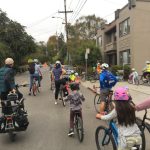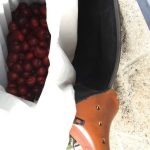Here in Oakland, 57% of people want to ride a bike more than they do now, according to a NACTO survey conducted in 2019. And biking makes a lot of sense for short to moderate distances. A 2-3-mile bike ride that takes 20 minutes by bike may take the same amount of time or longer by car - because of traffic and parking.
I timed this recently. Here's a 2.1 mile bike ride that took 10.5 minutes. Google maps estimates a 12 minute car drive, that doesn't include parking time:
Many trips are distances that one can easily bike
The Federal Highway Administration keeps data on automobile trip distances. 45% of trips are under 3 miles, and 35% are under 2 miles. More than 1 in 3 car trips could be replaced by a bike ride! This would be better for the environment, because cars emit exhaust that contributes to climate change. Our air would be cleaner, because in addition to the exhaust, car tires are responsible for a lot of air pollutants ("Car tires produce vastly more pollution than exhaust, tests show"). People would get more healthy physical activity. People would save money - wear and tear on their cars, the cost of car insurance, and the cost of gas and parking. People would have more fun. And people would be less likely to harm others. It is estimated by the National Highway Traffic Safety Administration that 42,915 people were killed by an automobile in 2021.
Here are some of the barriers that prevent people from riding their bikes more.
Safety: People want to feel safe while riding their bikes
Most survey respondents seem to be most concerned about their own safety. This makes sense, one shouldn't have to put themselves in a vulnerable position when trying to run daily errands or get a little bit of exercise. And obviously worrying a lot while doing something makes it a less enjoyable activity. If people are already unsure if they want to ride, feeling unsafe will likely push them to avoid riding their bikes. This is seen in the data: the biggest challenge for people in Oakland is sharing the road with aggressive drivers. 79% of people in Oakland cited that as a major concern.
The bike safety category has a lot of separate components though. People don't want to be killed by a car driver while riding, and they also don't want to crash due to a lack of their own riding skill. Some people are also concerned that they might be exposed to assault or harassment while riding.
Better infrastructure helps improve safety for all road users
I learned a surprising thing the other day. The lane width (in on one travel direction, measured using Google Earth) on Broadway St in Downtown Oakland is about 35 feet. This is the same width as one travel direction on a local highway, State Route 13. Some people will drive as fast as road conditions allow, and the road conditions are usually dictated by what the local department of transportation has decided to build as infrastructure.
A downtown street should not be as wide as a highway.
Building physical protection into bike lanes helps a lot. Sidewalks help people who walk by creating an area protected by a curb that is harder for people to drive onto. Protected bike lanes work in a similar way. A study by researches at the University of Colorado Denver found that protected bike lanes reduced the road fatality rate all users, including drivers.
Painted bike lanes don't really help, because some people are determined to drive in them anyway:

Here's a video of a bike ride through a protected bike lane (in this case via plastic bollards and car parking spots):
Curbs, bollards and bumps help prevent people from driving where they're not supposed to. Speed bumps, narrower roads, chicanes and bulbouts help slow traffic and ensure that space is used not just for cars. Elevated areas like protected crosswalks help highlight the visibility of road users that may be harder to see. In Cologne, Germany, many bike lanes are at the same level as the sidewalk, which helps provide protection and visibility.
Bicycle handling skills are also important
One of the great things about traveling by bicycle is that the since the external risks are lower (it's harder to hurt someone else via bike than via automobile) younger people can move themselves independently. Kids can bike themselves to school. But a certain level of skill in handling a bicycle is still necessary, and some people may not trust their own skill in riding a bike. I've found that this is highly related to sharing the road with cars though. Some people who say they're not sure of their skill level would feel comfortable riding on a separated bike path.
Harassment on a bike
In the NACTO survey, people in Oakland cited these two other safety concerns: "Being robbed or assaulted" and "Being stopped by the police". In areas with more crime, this is a big concern. People may also have fears of police brutality and discrimination.
Transporting cargo, other people, and storing the bike
A lot of daily errands may involve carrying something on your bike. If you are a parent and have kids, you may need to take your kids to school or to an activity. Getting groceries by bike means that you have to bring the groceries home somehow. Though carrying stuff by bike is trivial once you have things set up, it might be a barrier at first.
Transporting groceries or cargo by bike
49 percent of people in Oakland said that "Carrying things I need" is a challenge to riding a bike. A backpack is a obvious quick choice for smaller things, but for more stuff, it helps to have a bike with a rack and panniers. Each pannier can roughly hold the equivalent of a bag of groceries, and racks can fit two of them. The cost is fairly accessible: a sensible rear rack is about $40, while a set of panniers may be another $50.
This is less than would fit in the trunk of a typical car (maybe 4, 8, 12 bags would fit, depending on how comfortable you are with stacking?) but enough for small grocery hauls.
Cargobikes can haul even more. A pair of large panniers on a cargo bike can carry 4 bags of groceries.
This is a work in progress. Up next..
Taking your kids on your bike ride
Distance & Routes - and infrastructure's role in this
Bike condition or access & availability
Weather and environmental factors
Inertia and habits
Personal/Social reasons





